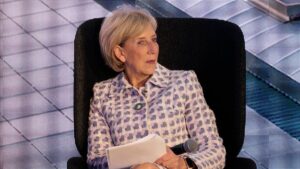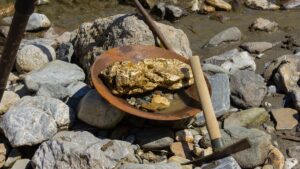Ground Breakers: BHP leads bumper day of results with Iluka, Ramelius and mining services plays also on the bill

Picture: Getty Images
- BHP boss Mike Henry says the company still likes “quality met coal” despite placing Queensland mines on the block
- Materials index falls as BHP investors digest fall from peak profits and dividends
- Ramelius, mining services stocks, Iluka and Alumina also report
BHP (ASX:BHP) boss Mike Henry has said the company’s returns to shareholders remain strong, saying the miner is paying over one-fifth of the dividends returned to Australian investors despite a fall in profits.
While BHP’s dividend fell 40% to US90c per share, equivalent to around $6.6 billion, profit was down 32% to US$6.457 billion and its payout ratio fell nine points to 69%, Henry was quick to mention the payout was the fifth largest in the company’s history.
In a sign of the grip the big miners have on the local market and their outsized role in public policy and business, Henry noted around 10% of the local ASX 200 index is contained in BHP’s $245 billion market cap.
That prompted a rough morning for the miners, down 0.41% with the ASX off 0.54% as investors digested what could be the end of the peak in BHP’s and the iron ore majors’ earnings last year.
Fortescue (ASX:FMG) last week lowered its dividend payout ratio to 65% from 70% a year earlier, with the big miners now facing tougher questions about whether to prioritise investments in decarbonisation (US$4bn by 2030 according to BHP), M & A (BHP is buying OZ Minerals for $9.6 billion), exploration and more.
Henry told media on a call this morning the big miner placed decarbonisation above growth capital in its allocation framework.
It comes as two major operations, the Daunia and Blackwater mines in BHP’s BMA met coal portfolio in Queensland fell afoul of that capital allocation equation, with BHP chucking them up for sale.
Still a met coal believer
Henry says the decision to put those two mines on the block, likely to be hunted by firms like Coronado (ASX:CRN), Peabody, Stanmore Coal (ASX:SMR) as well as private and overseas players, is about ensuring its coal portfolio is “the best of the best”.
It comes after increasing costs entered the business in the form of a large hike in royalties in Queensland.
BHP is also reviewing its long term mine plans at the Mt Arthur thermal coal mine in New South Wales, taken off the market and put into a plan to wind it down by the end of the decade, after the NSW Government issued a decree to reserve 5% of production for the domestic market at prices that wouldn’t cover BHP’s current cost of production.
Henry says BHP remains confident in keeping high quality met coal mines like Saraji, Peak Downs, Goonyella and Broadmeadow in its portfolio alongside its global ‘future facing’ iron ore, nickel, copper and potash assets.
“Really, the sales that we’ve announced today of Blackwater and Daunia are wholly consistent with what we’ve been saying for quite a number of years now,” Henry said.
“Which is that as the world and the steel industry seek to decarbonise and in fact accelerate on that effort, a key route for steelmakers to be able to reduce their carbon intensity will be through more efficient blast furnace operations. That requires the highest of quality coking coal.
“And that’s what we have in assets like Peak Downs, Goonyella, Saraji, Broadmeadow. And so those assets we see as having both sides through the energy transition. What we’re doing here is further concentrating our portfolio on the best of the best assets.”
Meanwhile, Henry said BHP had signed an MOU with a new state-owned iron ore buyer called the China Mineral Resources Group, understood to be responsible for co-ordinating overseas iron ore investments and negotiating purchases for China’s largest state-owned steel mills.
The country produces in excess of a billion tonnes of steel a year, almost 60% of the world’s total. But it has long complained about the outsized pricing power of Australia and Brazil’s more concentrated iron ore sellers, with spot prices rising over 60% in the past five months to around US$125/t, up on the ~US$86/t realised by BHP in the December half.
Henry didn’t comment on the impact of the CMRG on spot prices, instead focusing on “sustainable supply chains”.
“We maintain relationships with customers in China, and as I said, these are multifaceted relationships, which go beyond just the transactional aspects of selling iron ore to them,” he said.
“We’re working together with steelmakers that comprise about 20% of global steel production on their decarbonisation efforts, a big part of that is in China.
“And so CMRG is bringing an added dimension to the market, obviously acting as an agent for a number of the buyers, but the MOU speaks for itself, it’s multifaceted in nature and it’s all around how we go about ensuring more sustainable iron ore supply going into the future.”
Does the MoU speak for itself? Henry was similarly mum on whether BHP, which noted the continued uncertainty around Chinese imports of coal, had sold into the Middle Kingdom since an unofficial ban slowly began to lift earlier this year.
“The coal trade opening up to China? Overall, a net positive for the market,” he said.
“I don’t want to get into the nitty gritty of whether we’ve sold or we haven’t sold other than to say that, of course we welcome the opportunity to engage with customers in China on potential coal sales, whilst keeping in mind that we did need to pivot our sales towards other markets and we’ve got very strong customer relationships there.
“But we are and we’ll be engaging further with our very important and valued Chinese customers as well.”
BHP says its expects China to lead an improvement in global commodity demand in the second half.
BHP (ASX:BHP) share price today:
Iluka approves Riverina mine, pays big divvie
Tom O’Leary hailed “an extraordinary year” for the mineral sands miner and rare earths hopeful, posting a 45% lift in EBITDA to $917m, 61% rise in profits to $589m and 88% lift in its full year dividend to 45c after a 20c per share final payout.
“With scarcity, security and reliability of supply increasingly prominent considerations for many downstream customers, Iluka’s portfolio of high grade, high quality critical minerals products produced in Australia sees the company well placed,” O’Leary told the market.
“This is demonstrated by the key offtake agreements we have concluded for our synthetic rutile. New and existing customer commitments have increased over
the next four years, contracted under ‘take or pay’ arrangements. Production from our synthetic rutile kiln 2 (SR2) is effectively contracted and volumes from the adjacent and recently restarted SR1 are available for sale on a spot basis as planned.”
This market strength has seen Iluka approve the Balranald mine in the New South Wales Riverina, which includes a rutile and zircon rich orebody with by-products of high quantities of rare earths.
The mine would deliver 60,000tpa of rutile, 50,000tpa of zircon, 60-70,000tpa of synthetic rutile, 4000tpa of rare earths concentrates and 150,000tpa of sulphate ilmenite over a 9.5 year mine life with first production of the $480m operation in H1 2025.
The orebody is 60m deep, unusual for a mineral sands development, with Iluka pioneering a technology described as “keyhole surgery for critical minerals”.
“More significant still is the way these products will be delivered. Iluka’s UGM technology is akin to keyhole surgery for the mining of critical minerals,” O’Leary said.
“This enables access to ore bodies previously thought uneconomic, with marked reductions in both environmental disturbance and carbon intensity relative to traditional mineral sands extraction techniques, which are themselves less impactful than other commodities.
“The company has invested substantially in this technology over a number of years and we are pleased and excited at the prospect of its first full scale commercial deployment.”
The rare earths concentrates will provide additional feedstock for Iluka’s Eneabba refinery in WA, being built with the help of a $1.25 billion Commonwealth loan announced last year.
Iluka Resources (ASX:ILU) share price today:
Mining services stocks report
There has been mixed reactions to results from major mining contractors, with Perenti (ASX:PRN) outperforming expectations and Macmahon Holdings (ASX:MAH) and Monadelphous (ASX:MND) copping a hit from the market.
Perenti saw statutory NPAT(A) lift from $41.5m in H1 FY22 to $58.9m in H1 FY23, upgrading 2023 guidance after a 75% rise in underlying NPAT(A) to $61m, 67% jump in EBIT(A) to $134.6m and 39% climb in EBITDA to $281.2m on a 21% revenue lift to $1.4385b.
PRN has guided $2.8-2.9b of revenue and $250-265m of EBIT(A) for 2023, but warned that forecast assumed no deterioration of economic conditions.
Macmahon shares fell despite the contract digger reporting a $20m rise in statutory NPAT to $23.3m, with underlying NPAT down 6% to $29.8m. Underlying EBITDA was up 8% to $149.3m, with revenue up 22% to $987.2m.
MAH, which recently won $1.1b of work on the giant Greenbushes lithium mine in WA, has upped its revenue guidance by $250m to $1.85-1.95b for FY23 on cost recoveries, and announced an interim dividend of 0.3cps.
Monadelphous, meanwhile, reported NPAT of $29.1m on revenue of $953m, announcing a 24c per share interim dividend.
But MD Zoran Bebic warned the contractor continued to view skilled labour as an issue, tapping the reopening of the Australian border to try attract overseas labour to fill gaps.
“The resources and energy sectors, both in Australia and overseas, continue to provide a significant number of prospects for Monadelphous across a broad range of commodities, including iron ore, battery metals and oil and gas. The shortage of skilled labour, however, remains our biggest challenge, especially in Australia,” Bebic said.
Mining services share prices today:
Ramelius up despite profit slide
Ramelius Resources (ASX:RMS) has had a tough ride, down over 40% in the past year amid rising cost pressures in the gold sector.
But investors responded well to a “solid set of financial results”.
RMS delivered $32.7m in underlying half year NPAT and $29.1m of NPAT, down from $54.2m and $73.4m respectively, but toasted what it said was a still strong EBITDA margin of ~35%.
The big issue for Ramelius was costs and lower gold output, with all in sustaining costs up from $1473/oz to $2044/oz year on year in the first half and production down from 132,605oz to 118,000oz.
That underpinned a drop in EBITDA from $187.7m to $101.1m.
Managing director Mark Zeptner was bullish however on the impact of its high grade Penny gold mine over the coming years.
“Our underlying EBITDA of $106.3M was down on the prior corresponding period, but the margin remained a very competitive 35% for the six months. We believe this compares well with our peers and highlights that our business model remains robust,” he said.
“The first half of the year has been a period of investment for Ramelius as we look to bring one of the highest grade gold mines in Australia into steady state production early in 2023.
“Production from the Penny underground commenced late in 2022 and we expect this to ramp up in the March Quarter as the mine is developed and the upgrade of the haul road to Mt Magnet is also completed.
“Penny should have a materially favourable impact on the unit costs and cash generation for the Mt Magnet production centre for the next 2-3 years.”
Meanwhile Alumina (ASX:AWC) has said it will not declare a final dividend after seeing net profit after tax fall 45% to US$104m. AWC owns 40% of Alcoa’s World Alumina and Chemicals business.
It paid US2.8c last year and 4.2cps at the half year.
While alumina prices spiked in the early part of the year on Russia’s exclusion from global markets, a slowing global economy and power pricing combined to make the second half a tougher story, with higher average prices of US$371/t (+16%) outpaced by a 29% lift in costs to US$304/t.
AWAC’s NPAT fell 32% to US$301.1m, with EBITDA down 29% to US$817.1m and net cash inflow down 58% to US$204m.
Ramelius Resources (ASX:RMS) and Alumina (ASX:AWC) share price today:

UNLOCK INSIGHTS
Discover the untold stories of emerging ASX stocks.
Daily news and expert analysis, it's free to subscribe.
By proceeding, you confirm you understand that we handle personal information in accordance with our Privacy Policy.








